catalogue
Summary of naive Bayesian algorithm
1, Converter and estimator
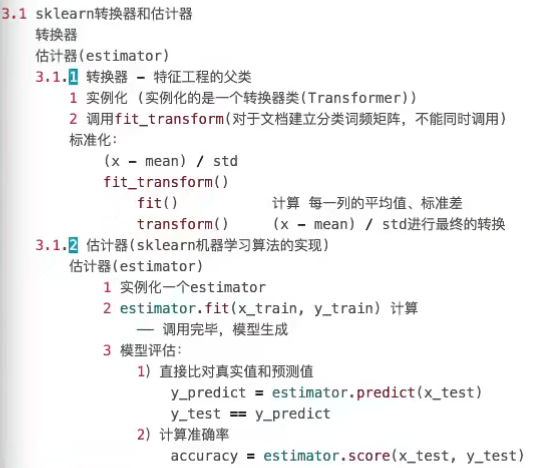
2, Classification algorithm
K-nearest neighbor algorithm
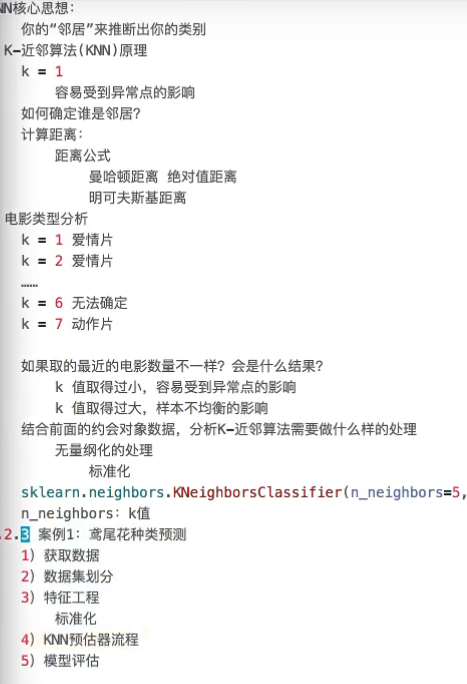
KNN algorithm summary:
advantage:
Simple, easy to understand, easy to implement, no training
Disadvantages:
1) the K value must be specified. If the K value is not selected properly, the classification accuracy cannot be guaranteed.
2) lazy algorithm, which has a large amount of calculation and memory overhead when classifying test samples
Usage scenario:
For small data scenarios, there are thousands to tens of thousands of samples. The specific use depends on the business scenario.
Case code:
from sklearn.datasets import load_iris
from sklearn.model_selection import train_test_split
from sklearn.preprocessing import StandardScaler
from sklearn.neighbors import KNeighborsClassifier
def knn_iris():
"""
use KNN Algorithm pair iris Data classification
:return:
"""
# 1) Get data
iris = load_iris()
# 2) Partition dataset
x_train, x_test, y_train, y_test = train_test_split(iris.data, iris.target, random_state=6
)
# 3) Feature Engineering: Standardization
transfer = StandardScaler()
x_train = transfer.fit_transform(x_train)
x_test = transfer.transform(x_test)
# 4) KNN algorithm predictor
estimator = KNeighborsClassifier(n_neighbors=3)
estimator.fit(x_train, y_train)
# 5) Model evaluation
# Method 1: directly compare the real value with the predicted value
y_predict = estimator.predict(x_test)
print("y_predict:\n", y_predict)
print("Direct comparison between real value and predicted value:\n", y_test == y_predict)
# Method 2: calculation accuracy
score = estimator.score(x_test, y_test)
print("The accuracy is:\n", score)
return None
if __name__ == '__main__':
# Code 1: classify iris data with KNN algorithm
knn_iris()
Model selection and tuning
Case code
from sklearn.datasets import load_iris
from sklearn.model_selection import train_test_split
from sklearn.preprocessing import StandardScaler
from sklearn.neighbors import KNeighborsClassifier
from sklearn.model_selection import GridSearchCV
def knn_iris_gscv():
"""
use KNN Algorithm pair iris Data classification,Add grid search and cross validation
:return:
"""
# 1) Get data
iris = load_iris()
# 2) Partition dataset
x_train, x_test, y_train, y_test = train_test_split(iris.data, iris.target, random_state=6
)
# 3) Feature Engineering: Standardization
transfer = StandardScaler()
x_train = transfer.fit_transform(x_train)
x_test = transfer.transform(x_test)
# 4) KNN algorithm predictor
estimator = KNeighborsClassifier()
# Join grid search and cross validation
# Parameter preparation
param_dict = {"n_neighbors": [1, 3, 5, 7, 9, 11]}
estimator = GridSearchCV(estimator, param_grid=param_dict, cv=10)
estimator.fit(x_train, y_train)
# 5) Model evaluation
# Method 1: directly compare the real value with the predicted value
y_predict = estimator.predict(x_test)
print("y_predict:\n", y_predict)
print("Direct comparison between real value and predicted value:\n", y_test == y_predict)
# Method 2: calculation accuracy
score = estimator.score(x_test, y_test)
print("The accuracy is:\n", score)
# Best parameter result: best_param_
print("Best parameters:\n", estimator.best_params_)
# Best result: best_score_
print("Best results:\n", estimator.best_score_)
# Best estimator: best_estimator_
print("Best estimator:\n", estimator.best_estimator_)
# Cross validation result: cv_results_
print("Cross validation results:\n", estimator.cv_results_)
return None
if __name__ == '__main__':
# Code 2: classify iris data with KNN algorithm, add grid search and cross validation
knn_iris_gscv()facebook data mining case:
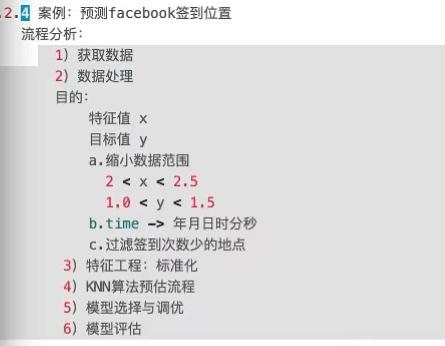
Case code:
import pandas as pd
from sklearn.model_selection import train_test_split, GridSearchCV
from sklearn.neighbors import KNeighborsClassifier
from sklearn.preprocessing import StandardScaler
def predict_data():
"""
Data preprocessing
:return:
"""
# 1) Read data
data = pd.read_csv("./train.csv")
# 2) Basic data processing
# narrow the range
data = data.query("x<2.5 & x>2 & y<1.5 & y>1.0")
# Processing time characteristics
time_value = pd.to_datatime(data["time"], unit="s")
date = pd.DatetimeIndex(time_value)
data.loc[:, "day"] = date.day
data.loc[:, "weekday"] = date.weekday
data["hour"] = data.hour
# 3) Filter locations with less check-in times
data.groupby("place_id").count()
place_count = data.groupby("place_id").count()["row_id"]
data_final = data[data['place_id'].isin(place_count[place_count > 3].index.vlaues)]
# Filter characteristic value and target value
x = data_final[["x", "y", "accuracy", "day", "weekday", "hour"]]
y = data_final["place_id"]
# Data set partition
# machine learning
x_train, x_test, y_train, y_test = train_test_split(x, y)
# 3) Feature Engineering: Standardization
transfer = StandardScaler()
x_train = transfer.fit_transform(x_train)
x_test = transfer.transform(x_test)
# 4) KNN algorithm predictor
estimator = KNeighborsClassifier()
# Join grid search and cross validation
# Parameter preparation
param_dict = {"n_neighbors": [1, 3, 5, 7, 9, 11]}
estimator = GridSearchCV(estimator, param_grid=param_dict, cv=3)
estimator.fit(x_train, y_train)
# 5) Model evaluation
# Method 1: directly compare the real value with the predicted value
y_predict = estimator.predict(x_test)
print("y_predict:\n", y_predict)
print("Direct comparison between real value and predicted value:\n", y_test == y_predict)
# Method 2: calculation accuracy
score = estimator.score(x_test, y_test)
print("The accuracy is:\n", score)
# Best parameter result: best_param_
print("Best parameters:\n", estimator.best_params_)
# Best result: best_score_
print("Best results:\n", estimator.best_score_)
# Best estimator: best_estimator_
print("Best estimator:\n", estimator.best_estimator_)
# Cross validation result: cv_results_
print("Cross validation results:\n", estimator.cv_results_)
return None
if __name__ == '__main__':
predict_data()
Naive Bayesian algorithm:
Case code
from sklearn.datasets import load_iris
from sklearn.model_selection import train_test_split
from sklearn.preprocessing import StandardScaler
from sklearn.neighbors import KNeighborsClassifier
from sklearn.model_selection import GridSearchCV
from sklearn.datasets import fetch_20newsgroups
from sklearn.feature_extraction.text import TfidfVectorizer
from sklearn.naive_bayes import MultinomialNB
def nb_news():
"""
Classification of news with naive Bayesian algorithm
:return:
"""
# 1) Get data
news = fetch_20newsgroups(subset="all")
# 2) Partition dataset
x_train, x_test, y_train, y_test = train_test_split(news.data, news.target)
# 3) Feature engineering text feature extraction tfidf
transfer = TfidfVectorizer()
x_train = transfer.fit_transform(x_train)
x_test = transfer.transform(x_test)
# 4) Naive Bayesian algorithm predictor flow
estimator = MultinomialNB()
estimator.fit(x_train, y_train)
# 5) Model evaluation
# Method 1: directly compare the real value with the predicted value
y_predict = estimator.predict(x_test)
print("y_predict:\n", y_predict)
print("Direct comparison between real value and predicted value:\n", y_test == y_predict)
# Method 2: calculation accuracy
score = estimator.score(x_test, y_test)
print("The accuracy is:\n", score)
return None
if __name__ == '__main__':
# Code 3: classify news with naive Bayesian algorithm
nb_news()Summary of naive Bayesian algorithm
Advantages:
It is not sensitive to missing data, and the algorithm is relatively simple. It is often used in text classification.
High classification accuracy and fast speed.
Disadvantages:
Due to the assumption of sample independence, if the features are related, the prediction effect is not obvious.
Decision tree
Case code:
from sklearn.datasets import load_iris
from sklearn.model_selection import train_test_split
from sklearn.preprocessing import StandardScaler
from sklearn.neighbors import KNeighborsClassifier
from sklearn.model_selection import GridSearchCV
from sklearn.datasets import fetch_20newsgroups
from sklearn.feature_extraction.text import TfidfVectorizer
from sklearn.naive_bayes import MultinomialNB
from sklearn.tree import DecisionTreeClassifier, export_graphviz
def decision_iris():
"""
Using decision tree pair iris Data classification
:return:
"""
# 1) Get dataset
iris = load_iris()
# 2) Partition dataset
x_train, x_test, y_train, y_test = train_test_split(iris.data, iris.target, random_state=22)
# 3) Decision tree predictor
estimator = DecisionTreeClassifier(criterion="entropy")
estimator.fit(x_train, y_train)
# 4) Model evaluation
# Method 1: directly compare the real value with the predicted value
y_predict = estimator.predict(x_test)
print("y_predict:\n", y_predict)
print("Direct comparison between real value and predicted value:\n", y_test == y_predict)
# Method 2: calculation accuracy
score = estimator.score(x_test, y_test)
print("The accuracy is:\n", score)
# Visual decision tree
export_graphviz(estimator, out_file="iris_tree.dot", feature_names=iris.feature_names)
return None
if __name__ == '__main__':
# Code 4: classify iris data with decision tree
decision_iris()
Decision tree support visualization:
A web page that converts a. dot file to a visual image: Graphviz Online
Decision tree summary:
advantage:
Visualization - highly explanatory
Disadvantages:
It is easy to produce over fitting. At this time, the effect of using random forest will be better
Experimental project of decision tree -- a case of titanic data
Case code:
import pandas as pd
from sklearn.feature_extraction import DictVectorizer
from sklearn.model_selection import train_test_split
from sklearn.tree import DecisionTreeClassifier, export_graphviz
def decision_titanic():
# 1. Get data
titanic = pd.read_csv("./titanic.csv")
print(titanic)
# Filter characteristic value and target value
x = titanic[["pclass", "age", "sex"]]
y = titanic["survived"]
# 2. Data processing
# 1) Missing value processing
x['age'].fillna(x["age"].mean(), inplace=True)
# 2) Convert to dictionary
x = x.to_dict(orient="records")
# 3. Data set partition
x_train, x_test, y_train, y_test = train_test_split(x, y, random_state=22)
transfer = DictVectorizer()
x_train = transfer.fit_transform(x_train)
x_test = transfer.transform(x_test)
# 3) Decision tree predictor
estimator = DecisionTreeClassifier(criterion="entropy", max_depth=8)
estimator.fit(x_train, y_train)
# 4) Model evaluation
# Method 1: directly compare the real value with the predicted value
y_predict = estimator.predict(x_test)
print("y_predict:\n", y_predict)
print("Direct comparison between real value and predicted value:\n", y_test == y_predict)
# Method 2: calculation accuracy
score = estimator.score(x_test, y_test)
print("The accuracy is:\n", score)
# Visual decision tree
export_graphviz(estimator, out_file="titanic_tree.dot", feature_names=transfer.get_feature_names())
if __name__ == '__main__':
decision_titanic()
Use random forest to achieve:
import pandas as pd
from sklearn.feature_extraction import DictVectorizer
from sklearn.model_selection import train_test_split
from sklearn.tree import DecisionTreeClassifier, export_graphviz
from sklearn.ensemble import RandomForestClassifier
from sklearn.model_selection import GridSearchCV
def decision_titanic():
# 1. Get data
titanic = pd.read_csv("./titanic.csv")
print(titanic)
# Filter characteristic value and target value
x = titanic[["pclass", "age", "sex"]]
y = titanic["survived"]
# 2. Data processing
# 1) Missing value handling
x['age'].fillna(x["age"].mean(), inplace=True)
# 2) Convert to dictionary
x = x.to_dict(orient="records")
# 3. Data set partition
x_train, x_test, y_train, y_test = train_test_split(x, y, random_state=22)
transfer = DictVectorizer()
x_train = transfer.fit_transform(x_train)
x_test = transfer.transform(x_test)
# 3) Random forest predictor
estimator = RandomForestClassifier()
# Join grid search and cross validation
# Parameter preparation
param_dict = {"n_estimators": [120, 200, 300, 500, 800, 1200],
"max_depth": [5, 8, 15, 25, 30]}
estimator = GridSearchCV(estimator, param_grid=param_dict, cv=3)
estimator.fit(x_train, y_train)
# 4) Model evaluation
# Method 1: directly compare the real value with the predicted value
y_predict = estimator.predict(x_test)
print("y_predict:\n", y_predict)
print("Direct comparison between real value and predicted value:\n", y_test == y_predict)
# Method 2: calculation accuracy
score = estimator.score(x_test, y_test)
print("The accuracy is:\n", score)
# Visual decision tree
export_graphviz(estimator, out_file="titanic_tree.dot", feature_names=transfer.get_feature_names())
if __name__ == '__main__':
decision_titanic()
Random forest summary
Advantages:
It can run effectively on large data sets
The input samples with high-dimensional features are processed without dimensionality reduction.
summary
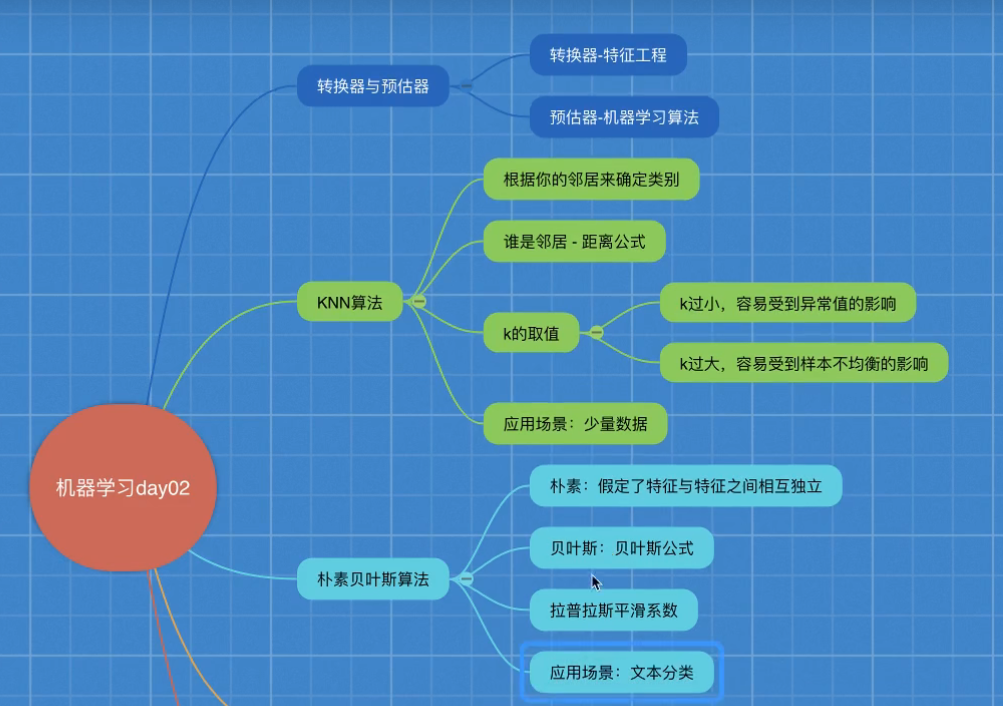
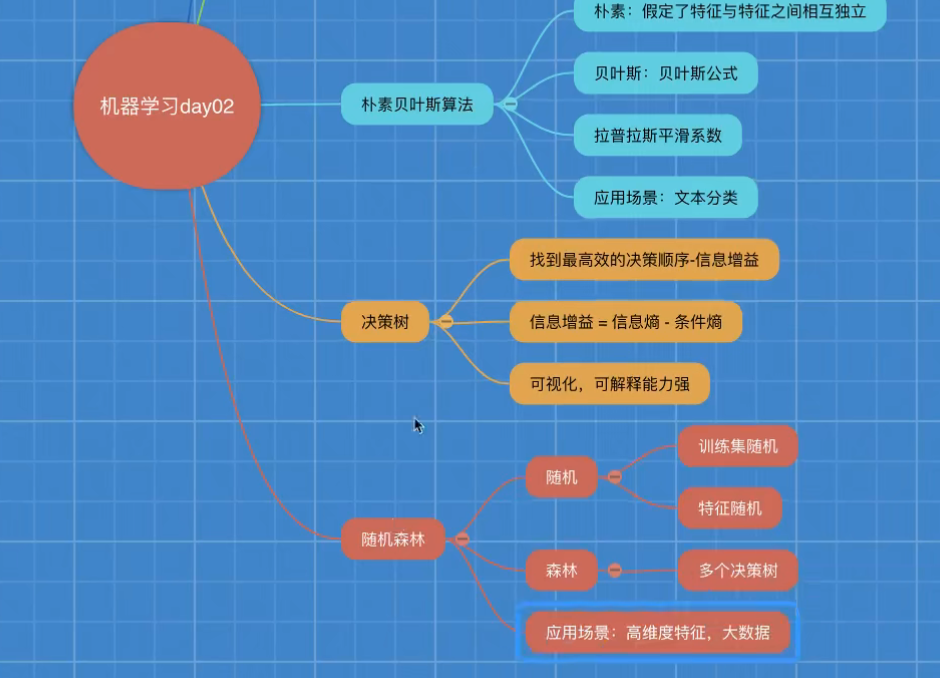
Code set of this case:
from sklearn.datasets import load_iris
from sklearn.model_selection import train_test_split
from sklearn.preprocessing import StandardScaler
from sklearn.neighbors import KNeighborsClassifier
from sklearn.model_selection import GridSearchCV
from sklearn.datasets import fetch_20newsgroups
from sklearn.feature_extraction.text import TfidfVectorizer
from sklearn.naive_bayes import MultinomialNB
from sklearn.tree import DecisionTreeClassifier, export_graphviz
def knn_iris():
"""
use KNN Algorithm pair iris Data classification
:return:
"""
# 1) Get data
iris = load_iris()
# 2) Partition dataset
x_train, x_test, y_train, y_test = train_test_split(iris.data, iris.target, random_state=6
)
# 3) Feature Engineering: Standardization
transfer = StandardScaler()
x_train = transfer.fit_transform(x_train)
x_test = transfer.transform(x_test)
# 4) KNN algorithm predictor
estimator = KNeighborsClassifier(n_neighbors=3)
estimator.fit(x_train, y_train)
# 5) Model evaluation
# Method 1: directly compare the real value with the predicted value
y_predict = estimator.predict(x_test)
print("y_predict:\n", y_predict)
print("Direct comparison between real value and predicted value:\n", y_test == y_predict)
# Method 2: calculation accuracy
score = estimator.score(x_test, y_test)
print("The accuracy is:\n", score)
return None
def knn_iris_gscv():
"""
use KNN Algorithm pair iris Data classification,Add grid search and cross validation
:return:
"""
# 1) Get data
iris = load_iris()
# 2) Partition dataset
x_train, x_test, y_train, y_test = train_test_split(iris.data, iris.target, random_state=6
)
# 3) Feature Engineering: Standardization
transfer = StandardScaler()
x_train = transfer.fit_transform(x_train)
x_test = transfer.transform(x_test)
# 4) KNN algorithm predictor
estimator = KNeighborsClassifier()
# Join grid search and cross validation
# Parameter preparation
param_dict = {"n_neighbors": [1, 3, 5, 7, 9, 11]}
estimator = GridSearchCV(estimator, param_grid=param_dict, cv=10)
estimator.fit(x_train, y_train)
# 5) Model evaluation
# Method 1: directly compare the real value with the predicted value
y_predict = estimator.predict(x_test)
print("y_predict:\n", y_predict)
print("Direct comparison between real value and predicted value:\n", y_test == y_predict)
# Method 2: calculation accuracy
score = estimator.score(x_test, y_test)
print("The accuracy is:\n", score)
# Best parameter result: best_param_
print("Best parameters:\n", estimator.best_params_)
# Best result: best_score_
print("Best results:\n", estimator.best_score_)
# Best estimator: best_estimator_
print("Best estimator:\n", estimator.best_estimator_)
# Cross validation result: cv_results_
print("Cross validation results:\n", estimator.cv_results_)
return None
def nb_news():
"""
Classification of news with naive Bayesian algorithm
:return:
"""
# 1) Get data
news = fetch_20newsgroups(subset="all")
# 2) Partition dataset
x_train, x_test, y_train, y_test = train_test_split(news.data, news.target)
# 3) Feature engineering text feature extraction tfidf
transfer = TfidfVectorizer()
x_train = transfer.fit_transform(x_train)
x_test = transfer.transform(x_test)
# 4) Naive Bayesian algorithm predictor flow
estimator = MultinomialNB()
estimator.fit(x_train, y_train)
# 5) Model evaluation
# Method 1: directly compare the real value with the predicted value
y_predict = estimator.predict(x_test)
print("y_predict:\n", y_predict)
print("Direct comparison between real value and predicted value:\n", y_test == y_predict)
# Method 2: calculation accuracy
score = estimator.score(x_test, y_test)
print("The accuracy is:\n", score)
return None
def decision_iris():
"""
Using decision tree pair iris Data classification
:return:
"""
# 1) Get dataset
iris = load_iris()
# 2) Partition dataset
x_train, x_test, y_train, y_test = train_test_split(iris.data, iris.target, random_state=22)
# 3) Decision tree predictor
estimator = DecisionTreeClassifier(criterion="entropy")
estimator.fit(x_train, y_train)
# 4) Model evaluation
# Method 1: directly compare the real value with the predicted value
y_predict = estimator.predict(x_test)
print("y_predict:\n", y_predict)
print("Direct comparison between real value and predicted value:\n", y_test == y_predict)
# Method 2: calculation accuracy
score = estimator.score(x_test, y_test)
print("The accuracy is:\n", score)
# Visual decision tree
export_graphviz(estimator, out_file="iris_tree.dot", feature_names=iris.feature_names)
return None
if __name__ == '__main__':
# Code 1: classify iris data with KNN algorithm
# knn_iris()
# Code 2: classify iris data with KNN algorithm, add grid search and cross validation
# knn_iris_gscv()
# Code 3: classify news with naive Bayesian algorithm
# nb_news()
# Code 4: classify iris data with decision tree
decision_iris()